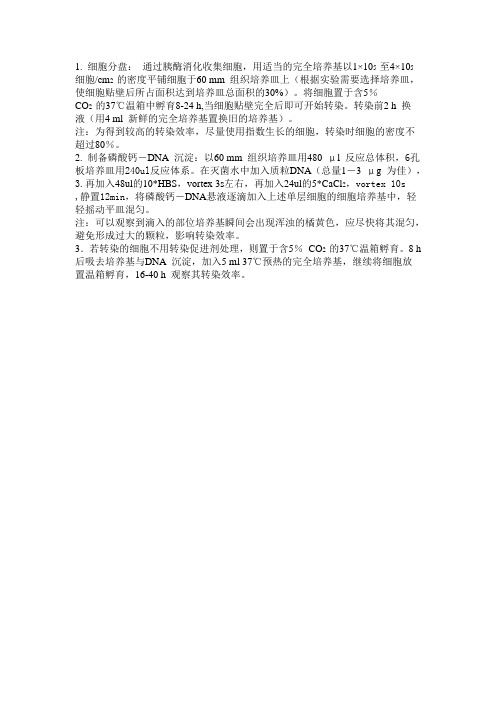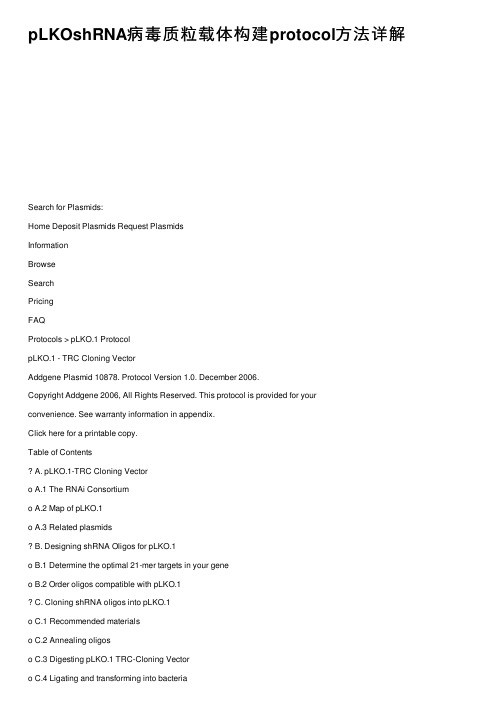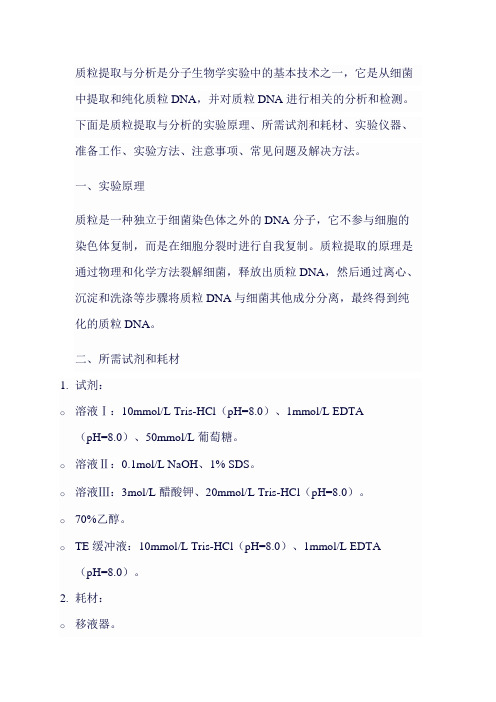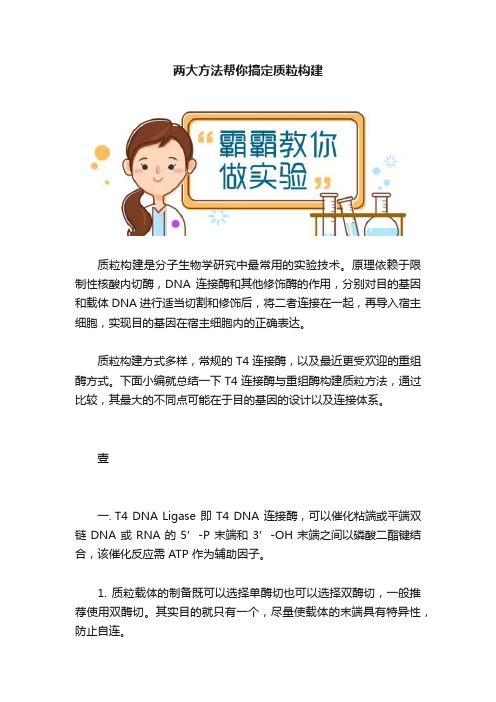质粒构建-protocol
质粒转染protocol

1. 细胞分盘:通过胰酶消化收集细胞,用适当的完全培养基以1×105 至4×105 细胞/cm2 的密度平铺细胞于60 mm 组织培养皿上(根据实验需要选择培养皿,使细胞贴壁后所占面积达到培养皿总面积的30%)。
将细胞置于含5%
CO2 的37℃温箱中孵育8-24 h,当细胞贴壁完全后即可开始转染。
转染前2 h 换
液(用4 ml 新鲜的完全培养基置换旧的培养基)。
注:为得到较高的转染效率,尽量使用指数生长的细胞,转染时细胞的密度不超过80%。
2. 制备磷酸钙-DNA 沉淀:以60 mm 组织培养皿用480 μl 反应总体积,6孔板培养皿用240ul反应体系。
在灭菌水中加入质粒DNA(总量1-3 μg 为佳),
3.再加入48ul的10*HBS,vortex 3s左右,再加入24ul的5*CaCl2,vortex 10s
,静置12min,将磷酸钙-DNA悬液逐滴加入上述单层细胞的细胞培养基中,轻轻摇动平皿混匀。
注:可以观察到滴入的部位培养基瞬间会出现浑浊的橘黄色,应尽快将其混匀,避免形成过大的颗粒,影响转染效率。
3.若转染的细胞不用转染促进剂处理,则置于含5%CO2 的37℃温箱孵育。
8 h 后吸去培养基与DNA 沉淀,加入5 ml 37℃预热的完全培养基,继续将细胞放
置温箱孵育,16-40 h 观察其转染效率。
质粒构建 (2)

质粒构建1. 引言质粒是一种重要的实验工具,广泛应用于基因工程、遗传学和生物学研究中。
质粒构建是指将感兴趣的DNA片段插入到质粒中的过程,用于进一步研究DNA序列的功能和相互作用。
本文将介绍质粒构建的基本原理和步骤。
2. 质粒构建的基本原理质粒构建需要以下几个基本要素:•质粒:质粒是一种环状的DNA分子,可存在于细菌、酵母等生物体内。
•DNA片段:DNA片段是质粒构建中要插入质粒的感兴趣DNA序列,可以通过PCR扩增、基因合成等方法得到。
•限制酶:限制酶是一种特殊的酶,能够识别和切割DNA的特定序列。
•连接酶:连接酶是一种酶,能够将DNA片段与质粒连接起来。
基于以上要素,质粒构建的基本原理如下:1.将质粒和目标DNA片段分别进行限制性内切酶切割。
限制酶切割会产生粘性末端或平滑末端的DNA片段。
2.使用连接酶将目标DNA片段与质粒连接起来。
连接酶能够将两条DNA片段的末端连接起来,形成一个完整的质粒。
3.利用转化或转染等方法将质粒导入到宿主细胞中。
质粒在宿主细胞中进行复制和表达。
3. 质粒构建的步骤质粒构建的具体步骤如下:3.1 质粒提取从质粒宿主细胞中提取质粒是质粒构建的第一步。
常用的质粒提取方法包括碱裂解法、盐溶解法、商业提取试剂盒等。
质粒提取的目的是获取纯度较高的质粒样本,便于后续实验操作。
3.2 目标DNA片段的获取目标DNA片段可以通过PCR扩增、基因合成等方法得到。
PCR扩增需要设计引物,引物的序列与目标DNA片段的两端相互衔接。
基因合成则需要将目标DNA序列依照设定的序列进行化学合成。
3.3 DNA片段与质粒的连接将目标DNA片段与质粒进行连接,需要使用连接酶。
连接酶则需要根据DNA片段和质粒的不同情况选择合适的连接酶和反应条件。
连接酶反应通常包括连接酶、DNA片段和质粒的混合体系,以及一定的温度和时间。
3.4 转化或转染将连接好的质粒导入到宿主细胞中,以使质粒在宿主细胞中进行复制和表达。
pLKOshRNA病毒质粒载体构建protocol方法详解

pLKOshRNA病毒质粒载体构建protocol⽅法详解Search for Plasmids:Home Deposit Plasmids Request PlasmidsInformationBrowseSearchPricingFAQProtocols > pLKO.1 ProtocolpLKO.1 - TRC Cloning VectorAddgene Plasmid 10878. Protocol Version 1.0. December 2006.Copyright Addgene 2006, All Rights Reserved. This protocol is provided for yourconvenience. See warranty information in appendix.Click here for a printable copy.Table of ContentsA. pLKO.1-TRC Cloning Vectoro A.1 The RNAi Consortiumo A.2 Map of pLKO.1o A.3 Related plasmidsB. Designing shRNA Oligos for pLKO.1o B.1 Determine the optimal 21-mer targets in your geneo B.2 Order oligos compatible with pLKO.1C. Cloning shRNA oligos into pLKO.1o C.1 Recommended materialso C.2 Annealing oligoso C.3 Digesting pLKO.1 TRC-Cloning Vectoro C.4 Ligating and transforming into bacteriaD. Screening for Insertso D.1 Recommended materialsPlasmid CartYour cart is empty.Recently ViewedpLKO.1 - TRC clo...Plasmid 10878pLVTHMPlasmid 12247Mammalian RNAi T...Collectiono D.2 Screening for insertsE. Producing Lentiviral Particleso E.1 Recommended materialso E.2 Protocol for producing lentiviral particles ? F. Infecting Target Cellso F.1 Recommended materialso F.2 Determining the optimal puromycin concentrationo F.3 Protocol for lentiviral infection and selection ?G. SafetyH. Referenceso H.1 Published articleso H.2 Web resourcesI. Appendixo I.1 Sequence of pLKO.1 TRC-Cloning Vectoro I.2 Recipeso I.3 Warranty informationBack to TopA. pLKO.1-TRC Cloning VectorA.1 The RNA i ConsortiumThe pLKO.1 cloning vector is the backbone upon which The RNAi Consortium (TRC) has built a library of shRNAs directed against 15,000 human and 15,000 mouse genes. Addgene is working with the TRC to make this shRNA cloning vector available to the scientific community. Please cite Moffat et al., Cell 2006 Mar; 124(6):1283-98 (PubMed) in all publications arising from the use of this vector.A.2 Map of pLKO.1pLKO.1 is a replication-incompetent lentiviral vector chosen by the TRC for expression of shRNAs. pLKO.1 can be introduced into cells via direct transfection, or can be converted into lentiviral particles for subsequent infection of a target cell line. Once introduced, the puromycin resistance marker encoded in pLKO.1 allows for convenient stable selection.A.3 Related ProductsThe following plasmids available from Addgene are recommended for use in conjunction with the pLKO.1 TRC-cloning vector.Note: pLKO.1 can also be used with packaging plasmid pCMV-dR8.2 dvpr (Addgene #8455) and envelope plasmid pCMV-VSVG (Addgene#8454) from Robert Weinberg's lab. For more information, visit Addgene's Mammalian RNAi Tools page.Several other laboratories have deposited pLKO derived vectors that may also be useful for your experiment. To see these vectors, visit Addgene's website and search for "pLKO".Back to TopB. Designing shRNA Oligos for pLKO.1B.1 Determining the Optimal 21-mer Targets in your GeneSelection of suitable 21-mer targets in your gene is the first step toward efficient gene silencing. Methods for target selection are continuously being improved. Below are suggestions for target selection.1. Use an siRNA selection tool to determine a set of top-scoring targets for your gene. For example, the Whitehead Institute for Biomedical Research hosts an siRNA Selection Program that can be accessed after a free registration(/doc/c66f21e6f8c75fbfc77db279.html /bioc/siRNAext/). If you have MacOS X, another excellent program is iRNAi, which is provided free by the company Mekentosj(/doc/c66f21e6f8c75fbfc77db279.html /irnai/).A summary of guidelines for designing siRNAs with effective gene silencing is included here:Starting at 25nt downstream of the start codon (ATG), search for 21nt sequences that match the pattern AA(N19). If no suitablematch is found, search for NAR(N17)YNN, where N is anynucleotide, R is a purine (A,G), and Y is a pyrimidine (C,U).G-C content should be 36-52%.Sense 3' end should have low stability – at least one A or T between position 15-19.Avoid targeting introns.Avoid stretches of 4 or more nucleotide repeats, especially repeated Ts because polyT is a termination signal for RNA polymerase III.2. To minimize degradation of off-target mRNAs, use NCBI's BLAST program. Select sequences that have at least 3 nucleotide mismatches to all unrelated genes.Addgene recommends that you select multiple targetsequences for each gene. Some sequences will be more effectivethan others. In addition, demonstrating that two different shRNAsthat target the same gene can produce the same phenotype willalleviate concerns about off-target effects.B.2 Ordering Oligos Compatible with pLKO.1To generate oligos for cloning into pLKO.1, insert your sense and antisense sequences from step B.1 into the oligos below. Do not change the ends; these bases are important for cloning the oligos into the pLKO.1 TRC-cloning vector.Forward oligo:5' CCGG—21bp sense—CTCGAG—21bp antisense—TTTTTG 3'Reverse oligo:5' AATTCAAAAA—21bp sense—CTCGAG—21bp antisense 3'For example, if the target sequence is (AA)TGCCTACGTTAAGCTATAC, the oligos would be:Forward oligo:5'CCGG AATGCCTACGTTAAGCTATAC CTCGAG GTATAGCTTAACGTA GGCATT TTTTTG 3'Reverse oligo:5'AATTCAAAAA AATGCCTACGTTAAGCTATAC CTCGAG GTATAGCTTA ACGTAGGCATT 3'Back to TopC. Cloning Oligos into pLKO.1The pLKO.1-TRC cloning vector contains a 1.9kb stuffer that is releasedupon digestion with EcoRI and AgeI.The oligos from section B contain the shRNA sequence flanked by sequences that are compatible with the sticky ends of EcoRI and AgeI. Forward and reverse oligos are annealed and ligated into the pLKO.1 vector, producing a final plasmid that expresses the shRNA of interest.C.1 Recommended MaterialsC.2 A nnealing Oligos1. Resuspend oligos in ddH2O to a concentration of 20 µM, then mix:5 µL Forward oligo5 µL Reverse oligo5 µL10x NEB buffer 235 µL ddH2O2. Incubate for 4 minutes at 95o C in a PCR machine or in a beaker of boiling water.3. If using a PCR machine, incubate the sample at 70o C for 10 minutes then slowly cool to room temperature over the period of several hours. If using a beaker of water, remove the beaker from the flame, and allow the water to cool to room temperature. This will take a few hours, but it is important for the cooling to occur slowly for the oligos to anneal.C.3 Digesting pLKO.1 TRC Cloning Vector1. Digest pLKO.1 TRC-cloning vector with AgeI. Mix:6 µg pLKO.1 TRC-cloning vector (maxiprep or miniprep DNA)5 µL10x NEB buffer 11 µL AgeIto 50 µL ddH2O> Incubate at 37o C for 2 hours.2. Purify with Qiaquick gel extraction kit. Elute in 30 µL of ddH2O.3. Digest eluate with EcoRI. Mix:30 µL pLKO.1 TRC-cloning vector digested with AgeI5 µL10x NEB buffer for EcoRI1 µL EcoRI14 µL ddH2O> Incubate at 37o C for 2 hours.4. Run digested DNA on 0.8% low melting point agarose gel until you can distinctly see 2 bands, one 7kb and one 1.9kb. Cut out the 7kb band and place in a sterile microcentrifuge tube.When visualizing DNA fragments to be used for ligation, useonly long-wavelength UV light. Short wavelength UV light willincrease the chance of damaging the DNA.5. Purify the DNA using a Qiaquick gel extraction kit. Elute in 30 µL of ddH2O.6. Measure the DNA concentration.C.4 Ligating and Transforming into Bacteria1. Use your ligation method of choice. For a standard T4 ligation, mix:2 µL annealed oligo from step C.2.20 ng digested pLKO.1 TRC-cloning vector from step C.3. (If you were unable to measure the DNA concentration, use 1 µL) 2 µL10x NEB T4 DNA ligase buffer 1 µL NEB T4 DNA ligaseto 20 µL ddH2O> Incubate at 16o C for 4-20 hours.2. Transfo rm 2 µL of ligation mix into 25 µL competent DH5 alpha cells, following manufacturer's protocol. Plate on LB agar plates containing 100 µg/mL ampicillin or carbenicillin (an ampicillin analog).Back to TopD. Screening for InsertsYou may screen for plasmids that were successfully ligated by restriction enzyme digestion. However, once you have identified the positive clones, it is important to verify the insert by conducting a sequencing reaction.D.1 Recommended MaterialsD.2 Screening for InsertsDay 1:1. Innoculate 5 colonies from each ligation into LB + 100 µg/mLampicillin or carbenicillin.Day 2:2. Spin down the cultures and use a miniprep kit to obtain DNA.3. Conduct a restriction digest with EcoRI and NcoI:1 µg miniprep DNA2 µL10x NEB buffer for EcoRI0.8 µL EcoRI0.8 µL NcoIto 20 µL ddH2O> Incubate at 37o C for 1-2 hours.4. Run the digestion products on a 1% agarose gel. You shouldsee two fragments, a 2kb fragment and a 5kb fragment.5. Sequence positive clones with pLKO.1 sequencing primer (5'CAA GGC TGT TAG AGA GAT AAT TGG A 3').You may need to adjust the sequencing conditions if theDNA polymerase has difficulty reading through thesecondary structure of the hairpin sequence.Back to TopE. Producing Lentiviral ParticlesBefore this step, you must contact your institution's Bio-Safety office to receive permission and institution-specific instructions. You must follow safety procedure s and work in an environment (e.g. BL2+) suitable for handling HIV-derivative viruse s.For transient knockdown of protein expression, you may transfect plasmid DNA directly into the target cells. The shRNA will be expressed, but the DNA is unlikely to be integrated into the host genome.For stable loss-of-function experiments, Addgene recommends that you generate lentiviral particles and infect the target cells. Addition of puromycin will allow you to select for cells that stably express your shRNA of interest.E.1 Recommended MaterialsNote: pLKO.1 could also be packaged using pCMV-dR8.2 dvpr and pCMV-VSVG from the Robert Weinberg lab. For more information, visit Addgene's Mammalian RNAi Tools page.E.2 Protocol for Producing Lentiviral ParticlesThis protocol is for transfection in a 6 cm plate. The protocol can be scaled to produce different amounts of virus as needed. Day 1:a. For each plasmid to be transfected, plate 7x105 HEK-293T cellsin 5 mL of media in a 6 cm tissue culture plate. Incubate cells at37o C, 5% CO2 overnight.Although cells should regularly be passaged in DMEM +10% FBS with penicillin/streptomycin, cells should beplated at this step in DMEM + 10% FBS without antibiotics(no penicillin or streptomycin).Day 2:b. Perform the transfection in the late afternoon because thetransfection mix should only be incubated with the cells for 12-15hours.c. In polypropylene microfuge tubes (do NOT use polystyrenetubes), make a cocktail for each transfection:1 µg pLKO.1 shRNA plasmid750 ng psPAX2 packaging plasmid250 ng pMD2.G envelope plasmidto 20 µl serum-free OPTI-MEMYou may want to vary the ratio of shRNA plasmid,packaging plasmid, and envelope plasmid to obtain theratio that gives you the optimal viral production.d. Create a master mix of FuGENE? 6 transfection reagent inserum-free OPTI-MEM. Calculate the amount of Fugene? andOPTI-MEM necessary given that each reaction will require 6 µLFuGENE? + 74 µL OPTI-MEM. For example:1x master mix: 6 µL FuGENE? + 74 µL OPTI-MEM5x master mix: 30 µL FuGENE? + 370 µL OPTI-MEM10x master mix: 60 µL FuGENE? + 740 µL OPTI-MEM In a polypropylene tube, add OPTI-MEM first. Pipette FuGENE? directly into the OPTI-MEM - do not allow FuGENE? to come incontact with the walls of the tube before it has been diluted. Mix byswirling or gently flicking the tube. Incubate for 5 minutes at roomtemperature.e. Add 80 µL of FuGENE? master mix to each tube from step c fora total volume of 100 µL. Pipette master mix direct ly into the liquidand not onto the walls of the tube. Mix by swirling or gently flickingthe tube.f. Incubate for 20-30 minutes at room temperature.g. Retrieve HEK-293T cells from incubator. The cells should be50-80% confluent and in DMEM that does not contain antibiotics.h. Without touching the sides of the dish, gently addDNA:FuGENE? mix dropwise to cells. Swirl to disperse mixtureevenly. Do not pipette or swirl too vigorously, as you do not wantto dislodge the cells from the plate.i. Incubate cells at 37o C, 5% CO2 for 12-15 hours.Day 3:j. In the morning, change the media to remove the transfectionreagent. Replace with 5 mL fresh DMEM + 10% FBS +penicillin/streptomycin. Pipette the media onto the side of the plateso as not to disturb the transfected cells.k. Incubate cells at 37o C, 5% CO2 for 24 hours.Day 4:l. Harvest media from cells and transfer to a polypropylenestorage tube. The media contains your lentiviral particles. Store at4o C.m. Add 5 mL of fresh media containing antibiotics to the cells andincubate at 37o C, 5% CO2 for 24 hours.Day 5:n. Harvest media from cells and pool with media from Day 4. Spinmedia at 1,250 rpm for 5 minutes to pellet any HEK-293T cellsthat were inadvertently collected during harvesting.In lieu of centrifugation, you may filter the media througha 0.45 µm filter to remove the cells. Do not use a 0.2 µmfilter, as this is likely to shear the envelope of your virus.o. Virus may be stored at 4o C for a few days, but should be frozenat -20o C or -80o C for long-term storage.Freeze/thaw cycles decrease the efficiency of the virus,so Addgene recommends that you use the virusimmediately or aliquot the media into smaller tubes toprevent multiple freeze/thaw cycles.Back to TopF. Infecting Target CellsLentiviral particles can efficiently infect a broad range of cell types, including both dividing and non-dividing cells. Addition of puromycin will allow you to select for cells that are stably expressing your shRNA of interest.F.1. Recommended Materials* Detailed protocols for preparing polybrene, protamine sulfate, andpuromycin are located in the Appendix.F.2. Determining the Optimal Puromycin ConcentrationEach cell line responds differently to puromycin selection. Addgene strongly recommends that you determine the optimal puromycin concentration for your cell line before initiating your experiment.Day 1:a. Plate target cells in ten 6 cm plates and grow at 37o C, 5% CO2overnight.Day 2:b. The target cells should be approximately 80-90% confluent.c. Dilute puromycin in the preferred culture media for your targetcells. The final concentration of puromycin should be from 1-10µg/mL in 1 µg/mL increments.d. Label plates from 1-10 and add appropriatepuromycin-containing media to cells.Days 3+:e. Examine cells each day and change to freshpuromycin-containing media every other day.f. The minimum concentration of puromycin that results in complete cell death after 3-5 days is the concentration that should be used for selection in your experiments. (You may wish to repeat this titration with finer increments of puromycin to determine a more precise optimal puromycin concentration.)F.3. Protocol for Lentiviral Infection and SelectionDay 1:a. Plate target cells and incubate at 37o C, 5% CO2 overnight. Day 2:b. Target cells should be approximately 70% confluent. Change to fresh culture media containing 8 µg/mL polybrene.Polybrene increases the efficiency of viral infection. However, polybrene is toxic to some cell lines. In these cell lines, substitute protamine sulfate for polybrene.c. Add lentiviral particle solution from step E. For a 6 cm target plate, add between 0.05-1 mL virus (add ≥0.5 mL for a high MOI, and ≤0.1 mL for a low MOI). Scale the amount of virus a dded depending on the size of your target plate.MOI (multiplicity of infection) refers to the number ofinfecting viral particles per cell. Addgene recommends thatyou test a range of MOIs to determine the optimal MOI for infection and gene silencing in your target cell line.d. Incubate cells at 37o C, 5% CO2 overnight.Day 3:e. Change to fresh media 24 hours after infection.If viral toxicity is observed in your cell line, you maydecrease the infection time to between 4 - 20 hours.Remove the virus-containing media and replace with freshmedia. Do not add puromycin until at least 24 hours afterinfection to allow for sufficient expression of the puromycinresistance gene.f. To select for infected cells, add puromycin to the media at theconcentration determined in step E.2.Addgene recommends that you maintain one uninfectedplate of cells in parallel. This plate will serve as a positivecontrol for the puromycin selection.Days 4+:g. Change to fresh puromycin-containing media as needed everyfew days.h. Assay infected cells. The following recommendations areguidelines for the number of days you should wait until harvestingyour cells. However, you should optimize the time based on yourcell line and assay:Assay Days post-infectionmRNA knockdown (quantitative PCR) ≥ 3 daysProtein knockdown (western blot) ≥ 4 daysPhenotypic assay ≥ 4 daysBack to TopG. SafetyBL2 safety practices should be followed when preparing and handling lentiviral particles. Personal protective clothing should be worn at all times. Use plastic pipettes in place of glass pipettes or needles. Liquid waste should be decontaminated with at least 10% bleach. Laboratory materials that come in contact with viral particles should be treated as biohazardous waste and autoclaved. Please follow all safety guidelines from your institution and from the CDC and NIH for work in a BL2 facility.If you have any questions about what safety practice to follow, please contact your institution's safety office.To obtain the MSDS for this product, visit /doc/c66f21e6f8c75fbfc77db279.html /sitemap and follow the MSDS link.Back to TopH. ReferencesH.1. Published A rticlesKhvorova A et. al. 2003. Functional siRNAs and miRNAs exhibit strand bias. Cell 115:209-216. (PubMed)Moffat J et. al. 2006. A lentiviral RNAi library for human and mouse genes applied to an arrayed viral high-content screen. Cell 124:1283-1298. (PubMed)Naldini L et. al. 1996. In vivo gene delivery and stable transduction of nondividing cells by a lentiviral vector. Science 272:263-267. (PubMed)Schwarz DS et. al. 2003. Asymmetry in the assembly of the RNAi enzyme complex. Cell 115:199-208. (PubMed)Stewart SA et. al. 2003. Lentivirus-delivered stable gene silencing by RNAi in primary cells. RNA 9(4):493-501. (PubMed) Zufferey R et. al. 1997. Multiply attenuated lentiviral vector achieves efficient gene delivery in vivo. Nat Biotechnol 15(9):871-5. (PubMed)Zufferey R et. al. 1998. Self-inactivating lentivirus vector for safe and efficient in vivo gene delivery. J Virol 72(12):9873-80. (PubMed)H.2. Web resourcesAddgene's mammalian RNAi website: /doc/c66f21e6f8c75fbfc77db279.html /rnaitoolsThe RNAi Consortium (TRC):/doc/c66f21e6f8c75fbfc77db279.html /genome_bio/trc/rnai.htmlBackground on RNAi mechanism:/doc/c66f21e6f8c75fbfc77db279.html /focus/rnai/animations/animation/animation.htm Whitehead siRNA Selection Program: /doc/c66f21e6f8c75fbfc77db279.html /bioc/siRNAext/ Mekentosj iRNAi Program: /doc/c66f21e6f8c75fbfc77db279.html /irnai/Back to TopI. AppendixI.1. Sequence of pLKO.1 TRC-Cloning VectorClick here (/doc/c66f21e6f8c75fbfc77db279.html /10878) to see the sequence of pLKO.1 TRC-cloning vector. The vector is 8901 base pairs total, and the stuffer insert is shown in all capital letters.I.2. RecipesLuria Broth Agar (LB agar) + antibioticPer 40 grams of powder from American Bioanalytical catalog #AB01200-02000, LB contains:10g tryptone5g yeast extract10g sodium chloride15g agar> Prepare LB agar solution by dissolving 40g of LB powder in 1Lof distilled water. Autoclave and cool to 55o C. Add 1mL of100mg/mL ampicillin or carbenicillin to obtain a final concentrationof 100 µg/mL antibiotic. Pour plates and store at 4o C.Hexadimethrine Bromide (Polybrene)Prepare a 1mg/mL solution of polybrene (Sigma-Aldrich catalog #H9268) in 0.9% NaCl. Autoclave to sterilize. Stock solution is stable at 4o C for up to one year. The powder form of polybrene is stable at 4o C for several years.Protamine SulfateStore protamine sulfate (MP Biomedicals catalog #194729) at 4o C. Freely soluble in hot water and slightly soluble in cold water.PuromycinPrepare a 50mg/mL stock solution of puromycin (Sigma-Aldrich catalog #P8833) in distilled water. Sterilize by passing through a 0.22 µm filter. Store aliquots at -20o C.I.3. Warranty InformationAddgene is committed to providing scientists with high-quality goods and services. Addgene makes every effort to ensure the accuracy of its literature, but realizes that typographical or other errors may occur. Addgene makes no warranty of any kind regarding the contents of any literature. Literature are provided to you as a guide and on an "AS IS" "AS AVAILABLE" basis without warranty of any kind either expressed or implied, including but not limited to the implied warranties of fitness for a particular purpose, non-infringement, typicality, safety and accuracy.The distribution of any literature by Addgene is not meant to carry with it, and does not grant any license or rights of access or use to the materials described in the literature.The distribution of materials by Addgene is not meant to carry with it, and does not grant any license, express or implied, under any patent. All transfers of materials from Addgene to any party are governed by Addgene's Terms of Use, Addgene's Terms of Purchase, and applicable Material Transfer Agreements between the party that deposited the material at Addgene and the party receiving the material.Back to TopHome | Contact | Terms of Use | Privacy Policy | Site Map。
质粒的构建原理

质粒的构建原理质粒是一种环状的DNA分子,常用于基因工程和基因转移研究中,具有无菌发酵的能力。
质粒构建是将外源基因插入质粒中,形成重组质粒,然后通过转化等方法将重组质粒导入目标细胞中,实现外源基因的表达。
质粒构建主要包括质粒选择、外源基因克隆、质粒复制源的选择和质粒验证等步骤。
首先,质粒选择是质粒构建的第一步。
常用的质粒有pUC、pBR322、pET等。
质粒的选择主要考虑质粒的大小、拷贝数和复制源。
较小的质粒易于操作,而高拷贝质粒有更高的表达效率;复制源是质粒复制和稳定维持的关键元件,常用的复制源有p15A、pMB1和ColE1等。
其次,外源基因克隆是质粒构建的核心步骤。
一般来说,先从源细胞中提取目标基因的DNA序列,然后使用PCR扩增或酶切方法将目标基因插入质粒的多克隆位点(多克隆位点是质粒上的一段特定区域,用于插入外源基因)。
在PCR扩增中,引物可以根据目标基因序列设计,将目标基因扩增出来;在酶切中,则需要使用一对限制酶切酶切剪目标基因和质粒,生成具有互补末端的片段,然后通过连接将目标基因与质粒连接起来,形成重组质粒。
质粒复制源的选择是质粒构建的重要一环。
质粒复制源是指负责质粒复制的DNA序列,可以使质粒在宿主细胞中进行自主复制。
不同的宿主细胞可能对不同的质粒复制源有不同的适应性。
此外,质粒复制源还涉及到质粒的拷贝数和稳定性。
通常来说,高拷贝质粒(如pUC)能够在细胞中形成较高的拷贝数,适合对外源基因进行高效表达;而低拷贝质粒(如p15A)则适合用于负载大片段DNA。
最后,质粒构建的最后一步是质粒验证。
质粒验证是为了确认重组质粒是否成功构建。
一种常见的验证方法是限制性酶切分析,通过对重组质粒进行限制酶切检测,可以观察到目标基因的大小变化,从而判断是否成功插入外源基因;另一种验证方法是测序分析,通过将重组质粒进行测序,可以得到目标基因的序列信息,验证插入的正确性。
总而言之,质粒构建的原理是将外源基因插入质粒中,通过质粒选择、外源基因克隆、质粒复制源的选择和质粒验证等步骤,构建出重组质粒。
质粒提取与分析 Protocol

质粒提取与分析是分子生物学实验中的基本技术之一,它是从细菌中提取和纯化质粒DNA,并对质粒DNA进行相关的分析和检测。
下面是质粒提取与分析的实验原理、所需试剂和耗材、实验仪器、准备工作、实验方法、注意事项、常见问题及解决方法。
一、实验原理质粒是一种独立于细菌染色体之外的DNA分子,它不参与细胞的染色体复制,而是在细胞分裂时进行自我复制。
质粒提取的原理是通过物理和化学方法裂解细菌,释放出质粒DNA,然后通过离心、沉淀和洗涤等步骤将质粒DNA与细菌其他成分分离,最终得到纯化的质粒DNA。
二、所需试剂和耗材1.试剂:o溶液Ⅰ:10mmol/L Tris-HCl(pH=8.0)、1mmol/L EDTA (pH=8.0)、50mmol/L葡萄糖。
o溶液Ⅱ:0.1mol/L NaOH、1% SDS。
o溶液Ⅲ:3mol/L醋酸钾、20mmol/L Tris-HCl(pH=8.0)。
o70%乙醇。
o TE缓冲液:10mmol/L Tris-HCl(pH=8.0)、1mmol/L EDTA (pH=8.0)。
2.耗材:o移液器。
o离心管和离心管盖。
o 1.5ml微量移液器。
o无菌水。
o0.22μm滤膜。
o培养板和涂布器。
o细菌培养液(如LB液体培养基)。
o氯仿。
o异戊醇。
三、实验仪器1.实验室搅拌器。
2.高速冷冻离心机。
3.水浴锅。
4.无菌工作台或超净工作台。
5.紫外线分光光度计。
6.电泳仪和电泳槽。
7.显微镜。
8.恒温摇床或振荡器。
9.烘箱或微波炉。
10.量筒和烧杯。
11.计时器。
12.手套和实验服。
四、准备工作1.阅读实验步骤和注意事项,了解所需的试剂和耗材及其使用方法。
2.准备好所需的试剂和耗材,并确保它们处于保质期内。
3.检查实验室内是否具备上述实验仪器,并确保其正常运行。
4.用70%乙醇擦拭实验台面,以确保无菌环境。
5.用高压蒸汽灭菌法灭菌所有的实验器具,包括离心管、移液器等。
6.设置离心机的高速和低速离心参数,以及水浴锅的温度等参数。
CRISPR protocol2-质粒构建和建系

CRISPR/Cas9系统操作说明-2 ---基于lentiCRISPR v2应用指南-载体构建和建系汉恒生物提供CRISPR/Cas9载体的快速构建试剂盒,同时也提供各种载体构建和病毒包装(慢病毒、腺病毒和AAV)、建系服务lentiCRISPR v2载体是张锋实验室发布一个慢病毒载体,cas9和sgRNA 表达框在同一各载体上。
而且Cas9的C 端带有FLAG 融合标签,载体包含Puromycin 抗性基因,适合建系。
验证sgRNA 活性的时候也适合顺转;包装成慢病毒适合常规细胞系的建系。
构建非常方便。
说明lentiCRISPR v2https:///52961/☐克隆gDNA 使用BsmBI 位点,载体可以切出一个~1.9 kb 的filler 片段,便于confirm 酶切成功并利于载体回收;☐BsmBI 的位点是,酶切之后不需要CIP 脱磷也不会自连!☐Cas9的COOH 端带有FLAG tag,可以WB 或者Immunostaining;☐EFS promoter 被优化的小而强,极大提高了慢病毒包装的效率;☐载体带有Puromycin 抗性,可以富集转染/感染成功的细胞。
☐gDNA 设计方法和原则请参考上第一篇“CRISPR/Cas9系统操作说明”,链接如下:☐对于lentiCRISPR v2克隆,其合成的oligo 末端和pX330不同,请注意设计;☐怕大家看不懂,举个例子说明(克隆小白千万注意oligo 的方向):gDNA 设计说明载体克隆说明☐Backbone的酶切体系同上一篇文章(说明:不脱磷处理参考黑框,脱磷参考红框内操作);☐Oligo的退火条件也参考上一篇文章(说明:如果载体不脱磷,oligo不需要磷酸化;载体脱磷参考红框内操作,oligo就需要加磷处理!!!(红色框内是FengZhang提供的protocol,设计脱磷,可以参考))仅作参考病毒包装体系☐包装病毒使用的包装体系如下(for 100 mm dish ,6x106293T )☐转染条件:用细胞转染试剂lipofiter (超便宜且好用)(汉恒生物,/cn/products/item/36,(或者lipo2000)DNA/lipofiter=1 μg :2.5 μl☐收集48hr 和72hr 病毒上清,待用。
两大方法帮你搞定质粒构建

两大方法帮你搞定质粒构建质粒构建是分子生物学研究中最常用的实验技术。
原理依赖于限制性核酸内切酶,DNA 连接酶和其他修饰酶的作用,分别对目的基因和载体 DNA 进行适当切割和修饰后,将二者连接在一起,再导入宿主细胞,实现目的基因在宿主细胞内的正确表达。
质粒构建方式多样,常规的 T4 连接酶,以及最近更受欢迎的重组酶方式。
下面小编就总结一下 T4 连接酶与重组酶构建质粒方法,通过比较,其最大的不同点可能在于目的基因的设计以及连接体系。
壹一. T4 DNA Ligase 即 T4 DNA 连接酶,可以催化粘端或平端双链 DNA 或 RNA 的5’-P 末端和3’-OH 末端之间以磷酸二酯键结合,该催化反应需 ATP 作为辅助因子。
1. 质粒载体的制备既可以选择单酶切也可以选择双酶切,一般推荐使用双酶切。
其实目的就只有一个,尽量使载体的末端具有特异性,防止自连。
[可选酶切体系]VECTOR 3 ugCutSmart Buffer 5 ul限制性内切酶 1 1 ul限制性内切酶 2 1 ul酶切体系一般选择 50ul,试剂加好之后37°C 孵育 6~8 小时,或适当延长时间,保证质粒酶切完全。
每隔一段时间振荡一下并离心以防液滴蒸发至管盖上。
酶切后载体通过切胶回收线性化载体。
2.根据目的序列构建引物后,引物设计原则简单总结一下:(1)前向引物:5’ 端-保护碱基序列+限制性内切酶 1 酶切位点序列+基因正向引物序列 -3’ 端(2)反向引物:5’ 端-保护碱基序列+限制性内切酶 2 酶切位点序列+基因反向引物序列 -3 ’端如果目的基因片段较长的话,可以选择 PCR 方式扩增目的基因片段[可选 PCR 扩增体系]ddH2O:14ul10xTaq buffer:2ul10um DNTP:1ul10um primer F:0.5ul10um primer R:0.5ul模板 DNA:1ulTaq 酶:1ul[可选 PCR 扩增条件](1)95℃:5min(2) 35cycle95℃:30s55℃:30s(退火温度可以根据目的引物TM值决定,一般退火温度根据引物TM值降低5度)72℃:40s(3)72℃:10min(4)16℃:hold引物扩增之后,首先要进行琼脂糖凝胶电泳验证条带大小,然后通过胶回收,获得纯化目的片段产物.由于加入保护碱基,回收产物需要进行双酶切,双酶切方法与质粒酶切方法相同。
质粒构建步骤

质粒构建步骤
嘿,你问质粒构建步骤啊?这事儿还挺复杂,不过咱慢慢说。
第一步呢,得先确定你要构建啥样的质粒。
就像你要盖房子,得先有个设计图吧。
想好你要把哪些基因放进去,要让质粒有啥功能。
这可不能瞎整,得有个明确的目标。
第二步,准备材料。
你得有合适的载体质粒,就像盖房子得有块地一样。
还有你要插进去的基因片段,这就好比盖房子的砖头瓦块啥的。
还得有各种酶啊,像剪刀一样把东西剪开再拼起来。
第三步,把基因片段剪下来。
用特定的酶在合适的位置把基因片段从原来的地方切下来。
这就像用剪刀把一块布剪成你想要的形状。
得小心点,可别剪坏了。
第四步,把基因片段插进载体质粒里。
这就像把一块拼图放进一个大拼图里一样。
用另一种酶把载体质粒打开一个口子,然后把基因片段塞进去。
再把口子封上,让它们连在一起。
第五步,验证一下你构建的质粒对不对。
可以用一些方法,比如测序啊,看看基因片段是不是插对地方了,有没有弄错啥的。
要是不对,就得重新来过。
比如说有个科学家想构建一个能让细菌发光的质粒。
他先想好要把哪个发光基因插进去,找好了载体质粒和各种酶。
然后小心翼翼地把发光基因剪下来,插进载体质粒里。
最后验证的时候发现插对了,可高兴了。
把这个质粒放到细菌里,细菌就真的发光了。
所以说啊,质粒构建可不是件容易的事,得一步一步来,细心又耐心。
咋样,现在知道质粒构建的步骤了吧?。
- 1、下载文档前请自行甄别文档内容的完整性,平台不提供额外的编辑、内容补充、找答案等附加服务。
- 2、"仅部分预览"的文档,不可在线预览部分如存在完整性等问题,可反馈申请退款(可完整预览的文档不适用该条件!)。
- 3、如文档侵犯您的权益,请联系客服反馈,我们会尽快为您处理(人工客服工作时间:9:00-18:30)。
一,引物设计:
1,选择合适的载体。
酶切位点及其顺序(酶切位点的顺序一定不能颠倒)。
2,在NCBI上再次确认目的片段的碱基序列。
1,使用word
2,设计引物:primer-up
Primer-down
3,核对----送公司合成。
4,对公司合成的引物离心,10000rpm、5-10分钟、at 4℃,在超净台按照管子上标注的体积加入高压水(2dH2O),再把上游引物和下游引物混在一起,at 4℃保存。
二,PCR(P出目的片段):
(一)、从韩家淮实验室赠送的菌液里P出目的片段:
12ul韩家淮实验室的菌液,
相应的抗生素
94℃ 5min
菌液1ul 94℃ 30sec
2x PFU mix 25ul 58℃ 30sec
Primer 1ul 72℃ X min
2d H2O 23ul 72℃ 5min
(X是根据片段的长度设定,500-1000bp/min,退火温度根据Tm值来计算,一般低于Tm值2℃)
3,跑胶、回收:
(1),配胶:
称0.6g的琼脂糖
加入60ml的1X TAE
加入0.6ul的EB(℃左右时)
25分钟后,即可点样跑胶。
(2),跑胶:130-150V、25-30分钟左右。
(3),紫外灯下观察,切胶(要带防护手套和口罩)
4,做胶回收(天根{TIANGEN}公司的DNA纯化回收试剂盒): 按照试剂盒的protocol来做,在胶回收的最后一步,Elution Buffer预先在55-65℃温箱中水浴,并且在加过EB后,放在37℃温
箱中2min。
对胶回收的产物跑胶验证。
可建立10ul的体系:回收产物2ul、10xloading buffer 2ul、2d H2O 6ul。
三,酶切、链接:
1,目的片段酶切:(37℃酶切过夜或者4小时)
insert :上述胶回收产物
35ul
10 x H buffer(1.5x)7ul
50ul的体系 dd H2O 6ul
酶1 1ul
酶2 1ul
2,载体酶切:(37℃酶切过夜或者4小时)
Vector (1ug/ul):2 ul
10 x buffer(1.5x)3ul
20ul的体系dd H2O 13ul
酶1 1ul
酶2 1ul
为方便以后使用,载体可以一次性多切点。
3,酶切时,首先要核对一下酶的buffer,有时双酶切时两个酶不能共用一种buffer,那么就要先切一端,酶切回收后再用另一酶切另一端,然后再酶切产物回收。
4,连接:
2x Rapid Ligation 6ul
Vector 0.8ul
12ul的体系insert 4.5ul
(目的是为了多加点insert)T4 DNA Lignase 1ul
四,转化:
⑴、冰上20分钟-→热激:42℃、90秒-→冰上2分钟
⑵、加1ml SOC(或者1ml LB),37℃、180 rpm、45分钟。
⑶、将上述转化后的菌液加入到100ml的LB中。
再按抗生素:LB=1:1000的比例加入抗生素,(100ml的LB加50ul的2Kx的氨苄)。
⑷、250rpm、过夜。
五,质粒大抽:
六,收菌:
取过夜菌至50毫升离心管,离心:6000g、3-5分钟、4℃。
再重复一次,每管共收集100毫升过夜菌沉淀。
(倒置于草纸上使液体流尽)。
七,重悬:
每管加入8ml的RES-EF(RnaseA),重悬细菌沉淀—充分V ortex或用枪头吹打沉淀。
确保沉淀完全散开,无可见细菌团块。
3,裂解:
每管加入等量的L YS-EF bufffer,即8ml。
轻轻上下颠倒离心管4-6次,(勿震!!)室温放置5min,使细菌完全裂解,溶液透明,无团块或絮状物。
注意:vortex或其它剧烈操作会导致基因组DNA断裂,易导致最终所得质粒被基因组DNA 污染
4,平衡:
⑴:滤芯插入柱子,将柱子驾于50ml离心管上(或者直接架于50ml离心管架上)
⑵:取15ml EQU-EF buffer 沿滤芯四周加入—充分平衡滤芯。
注意:①离心管内的液体不要浸没滤柱的头,所以要勤于倒弃滤液,②在过滤平衡液的同时,进行5、6步,防止滤芯干掉。
5,中和:
在等待EQU-EF buffer滤完时,往裂解好的菌液中加入8ml NEU-EF buffer,颠倒混匀,冰上孵育5min。
(不能vortex)
6,离心、过滤:
⑴:离心中和过的菌液:10000rpm、5-10min、at 4℃--质粒存在于上清中。
(离心使沉淀更加紧密,更集中于管底,对于进一步提高质粒质量会有所帮助)
⑵:将上清吸入到平衡好的滤芯中,重力自流尽。
7,洗一:
过滤完毕后,吸取5ml的FIL-EF buffer,沿滤芯四周加入(将粘在滤芯上的质粒洗下来)--过滤完后,将滤芯弃掉。
8,洗二:
往滤柱中加入35ml的ENDO-EF buffer—去内毒素
9,洗三:
待滤完后再加入15ml的wash-EF buffer—过滤。
10,洗脱:
取一支干净的15ml超速离心管,将滤完的柱子插入到离心管中,用高压条将二者绑好,往滤柱中加入5ml Elu-EF buffer.
(Elu-EF buffer预先放在50℃的恒温箱中加热,可提高洗脱效率)
11,沉淀:
待Elu-EF buffer滤完后,弃滤柱,往离心管中加入5ml的异丙醇(将质粒沉淀下来),混匀(充分vortex),静止10min---10000rpm、30min、4℃---弃上清。
12,洗涤:
加5ml的70%酒精(ETOH)或用15ml三蒸水(高压过)+35ml的无水乙醇配制(在超净台进行),混匀(上下颠倒即可),离心:10000rpm、10min、常温。
弃上清,重复上述步骤一次(再洗涤一次)弃上清---到超净台用200ul枪头把上清尽量洗净----再空离一次,在超净台用小枪头把液体洗净---吹干。
13,溶解:
取100-300ul高压过的H2O-EF溶解质粒--定量后,将质粒的浓度调至1ug/ul—最后,保存到-20℃。
